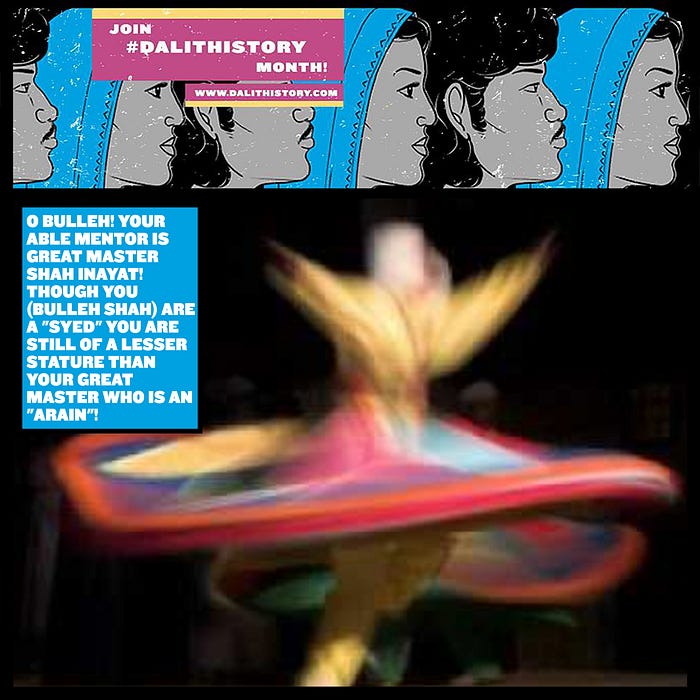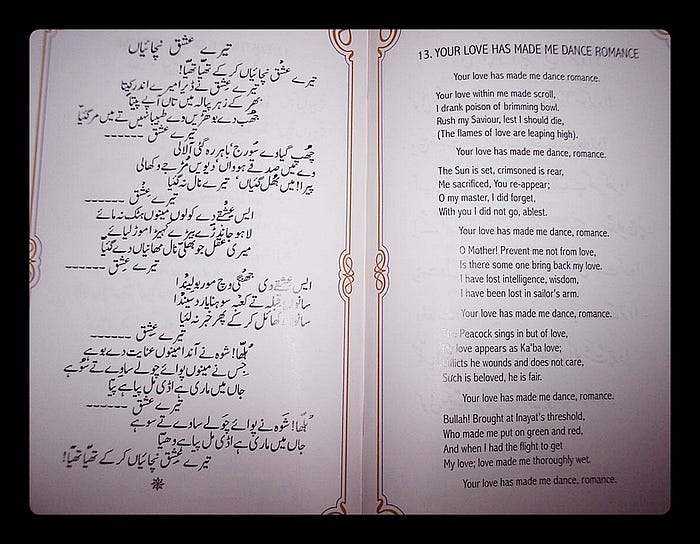Bulleh Shah & Shah Inayat — Caste in 17th Century Punjab
By Kriti Singh

Note to the reader: This piece contains a name word of an oppressed community that is also commonly used as slur. This word is Kanj*r. This is a casteist and anti-tribal practice that Dalit History Month condemns. In this text we have blurred out a letter of the word. This is not to perpetuate the negative connotations but to indicate that, as a reader, one should not necessarily engage with this word without an understanding of all its social and historical implications. Instead, we encourage readers, especially those not from this community, to self-evaluate, seek self-education on the issue and engage with the content mindfully.
Today in Dalit History, we recount the story of the relationship between Bulleh Shah and Shah Inayat Qadiri in 17th Century Punjab.
Strictly speaking, neither of these characters were “Dalit” per se. However, incidents around the lives of Shah Inayat and Bulleh betray a range of social expressions of gender and caste. They demonstrate how unique notions of caste materialised within Islamic communities, influenced not just by Brahmanical values, but also the local hierarchies of biradaris (clans) and genealogy.
Shah Inayat Qadiri was a Shaikh (spiritual teacher) to many in the Punjab region of present-day Pakistan. At that time, Bulleh Shah, an Ashraf Syedi (considered “upper” caste), was looking for such a teacher. On hearing about Shah Inayat, he decided to meet him and was completely taken by his charm and intelligence, decided that he would become his disciple.
Shah Inayat came from an Arain (gardeners, vegetable-growers, considered to be a “lower”) caste. When Bulleh Shah’s family had heard that he had chosen an Arain as Shaikh, they became furious and took it upon themselves to convince Bulleh Shah to leave him and find someone “more worthy”. “How can an Arain be a teacher to a Syed?” , he was asked.
Heart-broken, obligated and even a little swayed by his family’s convictions, Bulleh Shah went to Shah Inayat to declare that he would no longer be his disciple and stated his reason — the lowness and the highness, and the incompatibilities it presented. On hearing this, Shah Inayat was believed to have replied in only one line:
‘Tu Bullah nai tu bhulliyan ann’ (You are not Bulleh, you are lost)
Having walked away from Shah Inayat, Bulleh Shah began to become more and more confused. Shah’s words began repeatedly ringing in his mind. His longing and love for Shah Inayat is said to have grown unbearable. What was caste to him? Why had he thought that it had mattered more than his love for Shah Inayat? He realised what a terrible mistake he had made and ran back.
Bulleh pleaded:
Bulleya taira murshad kaamal Shah Inayat Saain!
Tun neewaan jeh sayyad vi ein uchha Saain Arain!
O Bulleh! Your able mentor is great master Shah Inayat!
Though you (Bulleh Shah) are a “Syed” you are still of a lesser stature than your great Master who is an “Arain”!
He had run back to him but Shah Inayat, displeased with his shallow and rapidly shifting states of mind, sent him away. Desperate, Bulleh remembered his Shaikh’s fondness for dances. He knew he had to rectify what he had done with an immense gesture. And so, in another misguided attempt, for 12 years, he is said to have gone to a community of street-dancers, the Kanj*rs. He attempted to “become” one of them — a “lowest” caste person. He lived among them and learned their dances, in what to him was, something of a penance — An upper caste Syed who was living like a Kanj*r. He seemed to have felt great vindication in this oppressed caste performance.
In a climactic act, Shah wore Kanj*r women’s clothes and began his final transcendent dance for Shah Inayat. This dancing was accompanied by his song — Tere Ishq Nachaya (Your Love has Made me Dance). In the song, Bulleh Shah pines for Shah Inayat and is willing to give anything up to see just a glimpse more of him. Sensing devotion and repentance, Shah Inayat is said to have forgiven him.

Source: https://www.thesufi.com/
This song that Bulleh Shah wrote for his “low” caste teacher is a cultural staple across large sections of India and Pakistan. It’s sung in villages, in cities, at weddings, at functions, all across faiths. There are qawaalis, folk versions, hip hop, rock versions, even Bollywood songs like Chayya Chayya are renditions. Many remember how Abida Parveen singing Tere Ishq Nachaya, still evokes intense sentiment among her listeners.
But there are still many questions that have remained unasked and unanswered. Why did Shah Inayat forgive Bulleh Shah and accept him despite the insults? Shah Inayat was himself, in fact, a celebrated poet and saint, but why doesn’t he occupy a position of eminence equal to that of Bulleh Shah in history? And what of the Kanj*r community — I wonder what they thought of Bulleh Shah doing “penance” among the lives they were living? And if they had resisted.
Some information on words like Kanj*r used in derogatory ways: https://scroll.in/article/817821/the-language-curse-how-proud-community-names-have-been-reduced-to-insults
SOURCES:
- https://en.wikipedia.org/wiki/Shah_Inayat_Qadiri
- https://suficrux.wordpress.com/2014/07/03/impeccable-voice-of-a-broken-heart/
- https://www.thesufi.com/story-behind-bulleh-shahs-tere-ishq-nachaya-karke-thaiya-thaiya/
- Shoaib, Mahwash. “Discourses of Learning and Love: Sufi Paths in Pakistan.” Decolonizing the Body of Christ. Palgrave Macmillan, New York, 2012. 141–158.
- Abbas, Qamar. “Bulleh Shah: The Sufi and the Poet of The Eighteenth Century Punjab.” (2016)